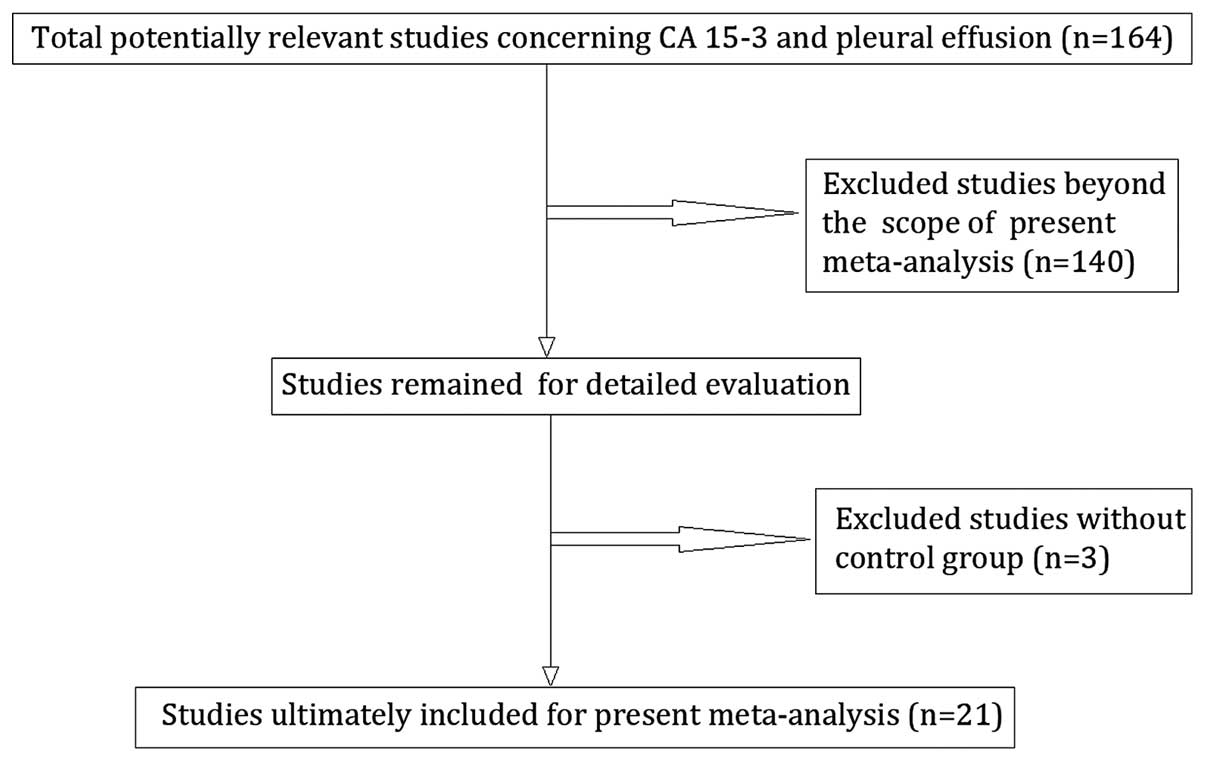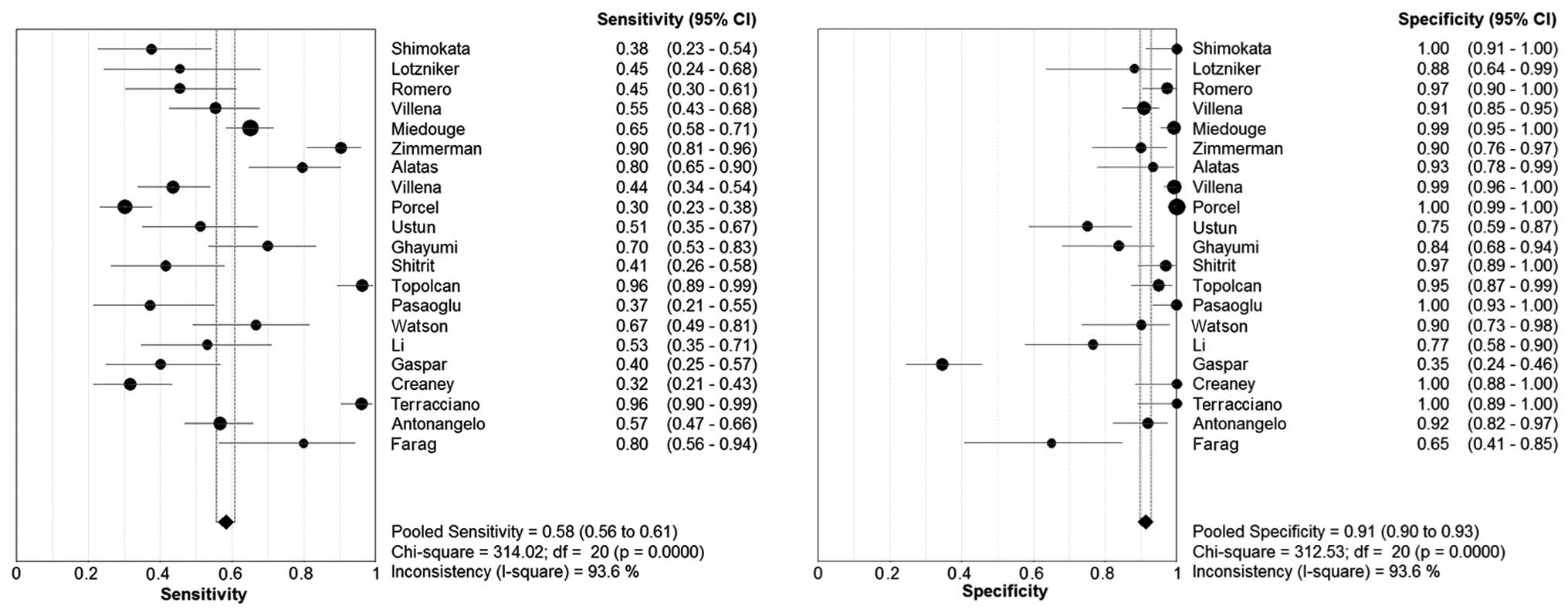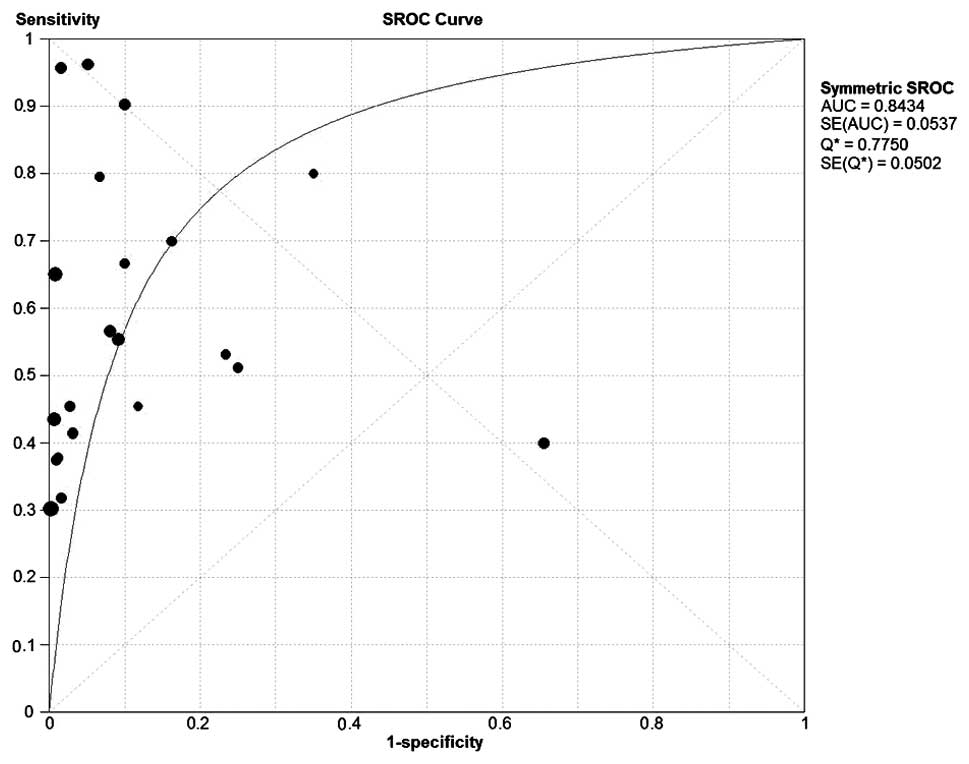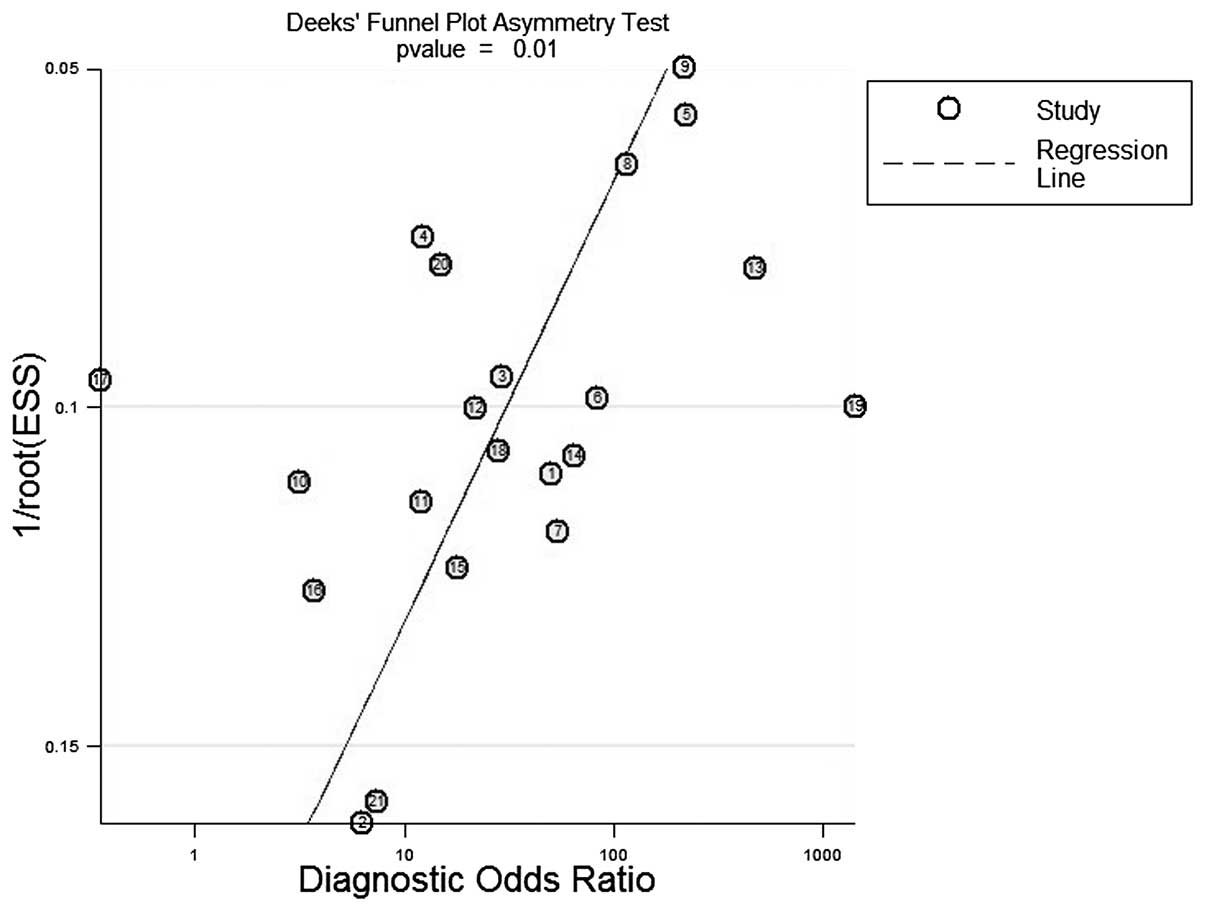|
1
|
American Thoracic Society. Management of
malignant pleural effusions. Am J Respir Crit Care Med.
162:1987–2001. 2001.
|
|
2
|
Heffner JE: Management of the patient with
a malignant pleural effusion. Semin Respir Crit Care Med.
31:723–733. 2010. View Article : Google Scholar
|
|
3
|
Light RW: Pleural effusion related to
metastatic malignancies. Pleural Diseases. 4th edition. Lippincott;
Philadelphia: pp. 133–161. 2001
|
|
4
|
Bennett R and Maskell N: Management of
malignant pleural effusions. Curr Opin Pulm Med. 11:296–300.
2005.PubMed/NCBI
|
|
5
|
Prakash UB and Reiman HM: Comparison of
needle biopsy with cytologic analysis for the evaluation of pleural
effusion: analysis of 414 cases. Mayo Clin Proc. 60:158–164. 1985.
View Article : Google Scholar : PubMed/NCBI
|
|
6
|
Nance KV, Shermer RW and Askin FB:
Diagnostic efficacy of pleural biopsy as compared with that of
pleural fluid examination. Mod Pathol. 4:320–324. 1991.PubMed/NCBI
|
|
7
|
Lombardi G, Zustovich F, Nicoletto MO,
Donach M, Artioli G and Pastorelli D: Diagnosis and treatment of
malignant pleural effusion: a systematic literature review and new
approaches. Am J Clin Oncol. 33:420–423. 2010. View Article : Google Scholar
|
|
8
|
Novaković S: Tumor markers in clinical
oncology. Radiol Oncol. 38:73–83. 2004.
|
|
9
|
Fenton KN and Richardson JD: Diagnosis and
management of malignant pleural effusions. Am J Surg. 170:69–74.
1995. View Article : Google Scholar : PubMed/NCBI
|
|
10
|
Porcel JM, Vives M, Esquerda A, Salud A,
Pérez B and Rodríguez-Panadero F: Use of a panel of tumor markers
(carcinoembryonic antigen, cancer antigen 125, carbohydrate antigen
15-3, and cytokeratin 19 fragments) in pleural fluid for the
differential diagnosis of benign and malignant effusions. Chest.
126:1757–1763. 2004. View Article : Google Scholar : PubMed/NCBI
|
|
11
|
Light RW: Tumor markers in undiagnosed
pleural effusions. Chest. 126:1721–1722. 2004. View Article : Google Scholar : PubMed/NCBI
|
|
12
|
Buccheri G and Ferrigno D: Lung tumor
markers of cytokeratin origin: an overview. Lung Cancer. 34(Suppl
2): S65–S69. 2001. View Article : Google Scholar : PubMed/NCBI
|
|
13
|
Shimokata K, Totani Y, Nakanishi K, et al:
Diagnostic value of cancer antigen 15-3(CA 15-3) detected by
monoclonal antibodies (115D8 and DF3) in exudative pleural
effusions. Eur Respir J. 1:341–344. 1988.PubMed/NCBI
|
|
14
|
Lotzniker M, Pavesi F, Scarabelli M,
Vadacca G, Franchi M and Moratti R: Tumour associated antigens CA
15-3 and CA 125 in ovarian cancer. Int J Bid Markers. 6:115–121.
1991.
|
|
15
|
Romero S, Fernandez C and Arriero JM: CEA,
CA15-3 and CYFRA21-1 in serum and pleural fluid of patients with
pleural effusions. Eur Respir J. 9:17–23. 1996. View Article : Google Scholar : PubMed/NCBI
|
|
16
|
Villena V, López-Encuentra A,
Echave-Sustaeta J, Martín-Escribano P, Ortuño-de-Solo B and
Estenoz-Alfaro J: Diagnostic value of CA 72-4, carcinoembrynic
antigen, CA 15-3 and CA 19-9 assay in pleural fluid: A study of 207
patients. Cancer. 78:736–740. 1996. View Article : Google Scholar : PubMed/NCBI
|
|
17
|
Miédougé M, Rouzand P, Salama G, et al:
Evaluation of seven tumor markers in pleural fluid for the
diagnosis of malignant effusions. Br J Cancer. 81:1059–1065. 1999.
View Article : Google Scholar
|
|
18
|
Zimmerman RL, Fogt F and Goonewardene S:
Diagnostic value of a second generation CA 15-3 antibody to detect
adenocarcinoma in body cavity effusions. Cancer Cytopathol.
90:230–234. 2000. View Article : Google Scholar
|
|
19
|
Alataş F, Alataş O, Metintaş M, Colak O,
Harmanci E and Demir S: Diagnostic value of CEA, CA 15-3, CA 19-9,
CYFRA 21-1, NSE and TSA assay in pleural effusions. Lung Cancer.
31:9–16. 2001. View Article : Google Scholar
|
|
20
|
Villena V, López-Encuentra A,
Echave-Sustaeta J, Martín-Escribano P, Ortuño-de-Solo B and
Estenoz-Alfaro J: Diagnostic value of CA 549 in pleural fluid,
Comparison with CEA, CA 15-3 and CA 72-4. Lung Cancer. 40:289–294.
2003. View Article : Google Scholar : PubMed/NCBI
|
|
21
|
Porcel JM, Vives M, Esquerda A, Salud A,
Pérez B and Rodríguez-Panadero F: Use of a panel of tumor markers
(carcinoembryonic antigen, cancer antigen 125, carbohy-drate
antigen 15-3 and cytokeratin 19 fragments) in pleural fluid for the
differential diagnosis of benign and malignant effusions. Chest.
126:1757–1763. 2004. View Article : Google Scholar : PubMed/NCBI
|
|
22
|
Ustün H, Borazan A, Bilgiçli N and Yilmaz
A: Diagnostic value of tumoural markers in pleural effusions. Int J
Clin Pract. 58:22–25. 2004. View Article : Google Scholar : PubMed/NCBI
|
|
23
|
Ghayumi SM, Mehrabi S, Doroudchi M and
Ghaderi A: Diagnostic value of tumor markers for differentiating
malignant and benign pleural effusions of Iranian patients. Pathol
Oncol Res. 11:236–241. 2005. View Article : Google Scholar
|
|
24
|
Shitrit D, Zingerman B, Shitrit AB, Shlomi
D and Kramer MR: Diagnostic value of CYFRA21-1, CEA, CA 19-9, CA
15-3 and CA 125 assays in pleural effusions: analysis of 116 case
and review of the literature. Oncologist. 10:501–507. 2005.
View Article : Google Scholar : PubMed/NCBI
|
|
25
|
Topolcan O, Holubec L, Polivkova V, et al:
Tumor markers in pleural effusions. Anticancer Res. 27:1921–1924.
2007.PubMed/NCBI
|
|
26
|
Paşaoğlu G, Zamani A, Can G and İmecik O:
Diagnostic value of CEA, CA 19-9, CA 125 and CA 15-3 levels in
malignant pleural fluids. Eur J Gen Med. 4:165–171. 2007.
|
|
27
|
Wagner IC, Guimarães MJ, da Silva LK, de
Melo FM and Muniz MT: Evaluation of serum and pleural levels of the
tumor markers CEA, CYFRA21-1 and CA 15-3 in patients with pleural
effusion. J Bras Pneumol. 33:185–191. 2007. View Article : Google Scholar : PubMed/NCBI
|
|
28
|
Li CS, Cheng BC, Ge W and Gao JF: Clinical
value of CYFRA21-1, NSE, CA15-3, CA19-9 and CA125 assay in the
elderly patients with pleural effusions. Int J Clin Pract.
61:444–448. 2007. View Article : Google Scholar : PubMed/NCBI
|
|
29
|
Gaspar MJ, De Miguel J, García Díaz JD and
Díez M: Clinical utility of a combination of tumor markers in the
diagnosis of malignant pleural effusions. Anticancer Res.
28:2947–2952. 2008.PubMed/NCBI
|
|
30
|
Creaney J, Segal A, Sterrett G, et al:
Overexpression and altered glycosylation of MUC1 in malignant
mesothelioma. Br J Cancer. 98:1562–1569. 2008. View Article : Google Scholar : PubMed/NCBI
|
|
31
|
Terracciano D, Mazzarelia C, Cicalese M,
et al: Diagnostic value of carbohydrate antigens in supernatants
and sediments of pleural effusions. Oncol Lett. 1:465–471.
2010.PubMed/NCBI
|
|
32
|
Antonangelo L, Cora AP and Sales MP:
Evaluation of pleural fluid levels and Pleural-Serum Ratio of the
tumor markers CEA, CA 15-3, CA 19-9, CA 72-4, CA 125 and CYFRA 21-1
in the diagnosis of malignant pleural effusion. Braz J Biol.
15:146–152. 2010.
|
|
33
|
Farag DH, El Hadidi E, El Maraghy MO and
Hussein MM: Pleural cyfra 21-1 and CA 15-3 in differentiation of
malignant from benign pleural effusions. Life Sci J. 9:499–505.
2012.
|
|
34
|
Whiting P, Rutjes AW, Reitsma JB, Bossuyt
PM and Kleijnen J: The development of QUADAS: a tool for the
quality assessment of studies of diagnostic accuracy included in
systematic reviews. BMC Med Res Methodol. 3:252003. View Article : Google Scholar : PubMed/NCBI
|
|
35
|
Jones CM, Ashrafian H, Skapinakis P, et
al: Diagnostic accuracy meta-analysis: a review of the basic
principles of interpretation and application. Int J Cardiol.
140:138–144. 2010. View Article : Google Scholar
|
|
36
|
Moses LE, Shapiro D and Littenberg B:
Combining independent studies of a diagnostic test into a summary
ROC curve: data-analytic approaches and some additional
considerations. Stat Med. 12:1293–1316. 1993. View Article : Google Scholar : PubMed/NCBI
|
|
37
|
Lau J, Ioannidis JP, Balk EM, et al:
Diagnosing acute cardiac ischemia in the emergency department: a
systematic review of the accuracy and clinical effect of current
technologies. Ann Emerg Med. 37:453–460. 2001. View Article : Google Scholar : PubMed/NCBI
|
|
38
|
Irwig L, Tosteson AN, Gatsonis C, et al:
Guidelines for meta-analyses evaluating diagnostic tests. Ann
Intern Med. 120:667–676. 1994. View Article : Google Scholar : PubMed/NCBI
|
|
39
|
Vamvakas EC: Meta-analyses of studies of
the diagnostic accuracy of laboratory tests: a review of the
concepts and methods. Arch Pathol Lab Med. 122:675–686.
1998.PubMed/NCBI
|
|
40
|
Suzuki S, Moro-oka T and Choudhry NK: The
conditional relative odds ratio provided less biased results for
comparing diagnostic test accuracy in meta-analyses. J Clin
Epidemiol. 57:461–469. 2004. View Article : Google Scholar : PubMed/NCBI
|
|
41
|
Westwood ME, Whiting PF and Kleijnen J:
How does study quality affect the results of a diagnostic
meta-analysis? BMC Med Res Methodol. 5:202005. View Article : Google Scholar : PubMed/NCBI
|
|
42
|
Deeks JJ, Dinnes J, D’Amico R, et al:
Evaluating non-randomised intervention studies. Health Technol
Assess. 7:1–173. 2003.
|
|
43
|
Bielsa S, Esquerda A, Salud A, et al: High
levels of tumor markers in pleural fluid correlate with poor
survival in patients with adenocarcinomatous or squamous malignant
effusions. Eur J Intern Med. 20:383–386. 2009. View Article : Google Scholar : PubMed/NCBI
|
|
44
|
Tampellini M, Berruti A, Gorzegno G, et
al: Independent factors predict supranormal CA 15-3 serum levels in
advanced breast cancer patients at first disease relapse. Tumor
Biol. 22:367–373. 2001. View Article : Google Scholar
|
|
45
|
Cascinu S, Del Ferro E, Barbanti I, Ligi
M, Fedeli A and Catalano G: Tumor markers in the diagnosis of
malignant serous effusions. Am J Clin Oncol. 20:247–250. 1997.
View Article : Google Scholar : PubMed/NCBI
|
|
46
|
Moses LE, Shapiro D and Littenberg B:
Combining independent studies of a diagnostic test into a summary
ROC curve: data-analytic approaches and some additional
considerations. Stat Med. 12:1293–1316. 1993. View Article : Google Scholar : PubMed/NCBI
|
|
47
|
Glas AS, Lijmer JG, Prins MH, Bonsel GJ
and Bossuyt PM: The diagnostic odds ratio: a single indicator of
test performance. J Clin Epidemiol. 56:1129–1135. 2003. View Article : Google Scholar : PubMed/NCBI
|
|
48
|
Deeks JJ: Systematic reviews of
evaluations of diagnostic and screening tests. Systematic Reviews
in Health Care: Meta-analysis in Context. Egger M, Smith GD and
Altman DG: 2nd edition. BMJ Publishing Group; London, UK: pp.
248–282. 2001, View Article : Google Scholar
|
|
49
|
Jaeschke R, Guyatt G and Lijmer J:
Diagnostic tests. Users’ Guides to the Medical Literature: A Manual
for Evidence-based Clinical Practice. Guyatt G and Rennie D: AMA
Press; Chicago, IL: pp. 121–140. 2002
|
|
50
|
Liang QL, Shi HZ, Qin XJ, Liang XD, Jiang
J and Yang HB: Diagnostic accuracy of tumor markers for malignant
pleural effusion: a meta-analysis. Thorax. 63:35–41. 2008.
View Article : Google Scholar
|


















